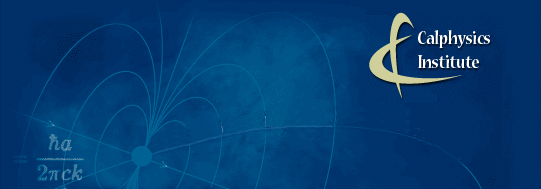Calphysics Home |
Research |
Scientific Articles |
Popular Articles |
Recommended Books
Nature of Mass |
Origin of Inertia |
Gravitation |
Zero-Point Energy |
Questions and Answers

"Advances are made by answering questions. Discoveries are made by questioning answers."
Bernard Haisch
Director
The primary mission of the Calphysics Institute is to carry out research on the electromagnetic quantum vacuum, with emphasis on the formulation and execution of experiments to elucidate the properties of the quantum vacuum and to search for possible technological applications.
The Calphysics Institute is the research organization led by Bernard Haisch, president of the non-profit Digital Universe Foundation. The Digital Universe is creating a global collaboration of experts and educators to collaboratively build a free, public-service oriented, non-commercial subset of the Web that will become a trustworthy and visually engaging repository of human knowledge, ultimately evolving into the kind of "Encyclopedia Galactica" envisioned by Carl Sagan.
This research program began as an informal collaboration between A. Rueda and B. Haisch in 1991 to investigate the possible role of the electromagnetic quantum vacuum in astrophysics and in areas of fundamental physics. Studies were carried out at the California State University in Long Beach (Rueda) and both the Lockheed Solar and Astrophysics Laboratory in Palo Alto and the Max Planck Institute fuer extraterrestrische Physik in Garching, Germany (Haisch). These investigations resulted in publication of the papers "Inertia as a zero-point field Lorentz force" by Haisch, Rueda and Puthoff in the Physical Review (Vol. 48, pp. 678-694, 1994) and "Vacuum Zero-point Field Pressure Instability in Astrophysical Plasmas and the Formation of Cosmic Voids" by Rueda, Haisch and Cole in the Astrophysical Journal (Vol. 445. pp. 7-16, 1995).
Based on this work, a multi-year NASA study (funded by NASA Headquarters and separate from the Breakthrough Propulsion Physics Program) began in 1996 at the Lockheed Martin Advanced Technology Center. Toward the end of the NASA study, over $2M in private philanthropic funding became available and as a result the California Institute for Physics and Astrophysics (CIPA) was established in Palo Alto. From 1999 to 2002, CIPA employed a full-time staff of seven (director, administrator and five postdoctoral physics researchers) and spanned a broad range of topics including General Relativity, Quantum Cosmology, String Theory, M-Brane Theory, and Cosmological Inflation in addition to studies of the quantum vacuum.
CIPA Research Fellows and Grantees
Daniel C. Cole (Boston Univ.), Trevor Marshall, Giovanni Modanese (Univ. Bolzano), Alfonso Rueda (Cal. State Univ. Long Beach), Bahaa E. A. Saleh (Boston Univ.), Christian J. F. Schubert (Max Planck Inst. fuer Gravitationsphysik), Alexander V. Sergienko (Boston Univ.), Malvin C. Teich (Boston Univ.) Edi Halyo (Dept. Physics, Stanford Univ.), Roh Tung (Center for Astrophysics, Shanghai Normal University), Marina Shmakova (SLAC, Stanford Univ.), Velvel Hushwater, Vlad SavchenkoPrimary Articles (See Scientific Articles for additional articles. Click here for new popular-level overview by Marcus Chown.)
Quantum Vacuum and Inertial Reaction in Nonrelativistic QED
Hiroki Sunahata, Alfonso Rueda and Bernard Haisch, arXiv:1306.6036 [physics.gen-ph] (2013).Gravity and the Quantum Vacuum Inertia Hypothesis
Alfonso Rueda & Bernard Haisch, Annalen der Physik, Vol. 14, No. 8, 479-498 (2005).Review of Experimental Concepts for Studying the Quantum Vacuum Fields
E. W. Davis, V. L. Teofilo, B. Haisch, H. E. Puthoff, L. J. Nickisch, A. Rueda and D. C. Cole, Space Technology and Applications International Forum (STAIF 2006), p. 1390 (2006).Analysis of Orbital Decay Time for the Classical Hydrogen Atom Interacting with Circularly Polarized Electromagnetic Radiation
Daniel C. Cole & Yi Zou, Physical Review E, 69, 016601, (2004).Inertial mass and the quantum vacuum fields
Bernard Haisch, Alfonso Rueda & York Dobyns, Annalen der Physik, Vol. 10, No. 5, 393-414 (2001).Stochastic nonrelativistic approach to gravity as originating from vacuum zero-point field van der Waals forces
Daniel C. Cole, Alfonso Rueda, Konn Danley, Physical Review A, 63, 054101, (2001).The Case for Inertia as a Vacuum Effect: a Reply to Woodward & Mahood
Y. Dobyns, A. Rueda & B.Haisch, Foundations of Physics, Vol. 30, No. 1, 59 (2000).
On the relation between a zero-point-field-induced inertial effect and the Einstein-de Broglie formula
B. Haisch & A. Rueda, Physics Letters A, 268, 224, (2000).Contribution to inertial mass by reaction of the vacuum to accelerated motion
A. Rueda & B. Haisch, Foundations of Physics, Vol. 28, No. 7, pp. 1057-1108 (1998).Inertial mass as reaction of the vacuum to acccelerated motion
A. Rueda & B. Haisch, Physics Letters A, vol. 240, No. 3, pp. 115-126, (1998).Reply to Michel's "Comment on Zero-Point Fluctuations and the Cosmological Constant"
B. Haisch & A. Rueda, Astrophysical Journal, 488, 563, (1997).Quantum and classical statistics of the electromagnetic zero-point-field
M. Ibison & B. Haisch, Physical Review A, 54, pp. 2737-2744, (1996).Vacuum Zero-Point Field Pressure Instability in Astrophysical Plasmas and the Formation of Cosmic Voids
A. Rueda, B. Haisch & D.C. Cole, Astrophysical Journal, Vol. 445, pp. 7-16 (1995).Inertia as a zero-point-field Lorentz force
B. Haisch, A. Rueda & H.E. Puthoff, Physical Review A, Vol. 49, No. 2, pp. 678-694 (1994).
The Calphysics Institute
admin@calphysics.org